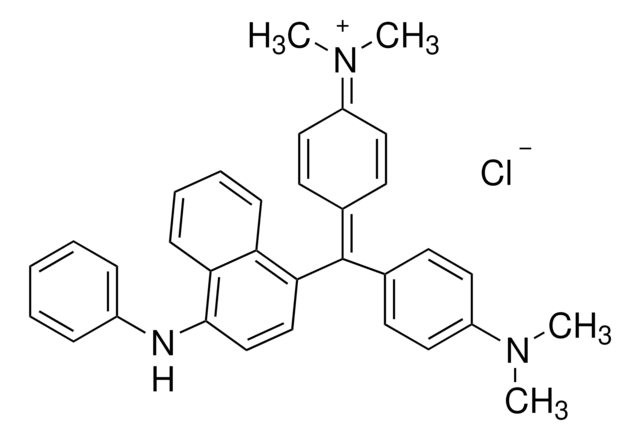230987
Victoria Pure Blue BO
Dye content 90 %
Sinónimos:
Basic Blue 7
About This Item
Productos recomendados
formulario
powder, crystals or chunks
Nivel de calidad
composición
Dye content, 90%
solubilidad
95% ethanol: 0.1%, blue to very deep blue
λmáx.
619 nm
aplicaciones
diagnostic assay manufacturing
hematology
histology
temp. de almacenamiento
room temp
cadena SMILES
[Cl-].CCNc1ccc(\C(c2ccc(cc2)N(CC)CC)=C3/C=C\C(C=C3)=[N+](\CC)CC)c4ccccc14
InChI
1S/C33H39N3.ClH/c1-6-34-32-24-23-31(29-13-11-12-14-30(29)32)33(25-15-19-27(20-16-25)35(7-2)8-3)26-17-21-28(22-18-26)36(9-4)10-5;/h11-24H,6-10H2,1-5H3;1H
Clave InChI
ROVRRJSRRSGUOL-UHFFFAOYSA-N
¿Está buscando productos similares? Visita Guía de comparación de productos
Categorías relacionadas
Descripción general
Palabra de señalización
Danger
Frases de peligro
Consejos de prudencia
Clasificaciones de peligro
Acute Tox. 3 Oral - Aquatic Acute 1 - Aquatic Chronic 1 - Eye Dam. 1
Código de clase de almacenamiento
6.1C - Combustible acute toxic Cat.3 / toxic compounds or compounds which causing chronic effects
Clase de riesgo para el agua (WGK)
WGK 3
Punto de inflamabilidad (°F)
Not applicable
Punto de inflamabilidad (°C)
Not applicable
Equipo de protección personal
Eyeshields, Gloves, type N95 (US)
Choose from one of the most recent versions:
¿Ya tiene este producto?
Encuentre la documentación para los productos que ha comprado recientemente en la Biblioteca de documentos.
Los clientes también vieron
Nuestro equipo de científicos tiene experiencia en todas las áreas de investigación: Ciencias de la vida, Ciencia de los materiales, Síntesis química, Cromatografía, Analítica y muchas otras.
Póngase en contacto con el Servicio técnico













